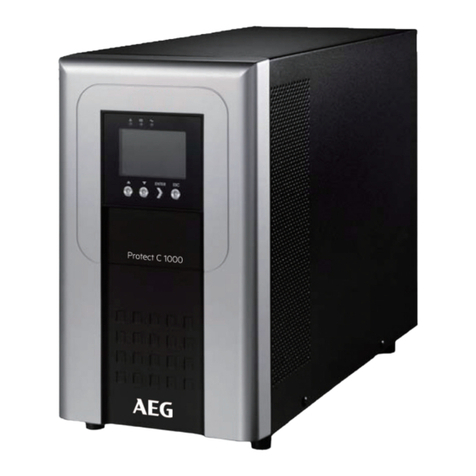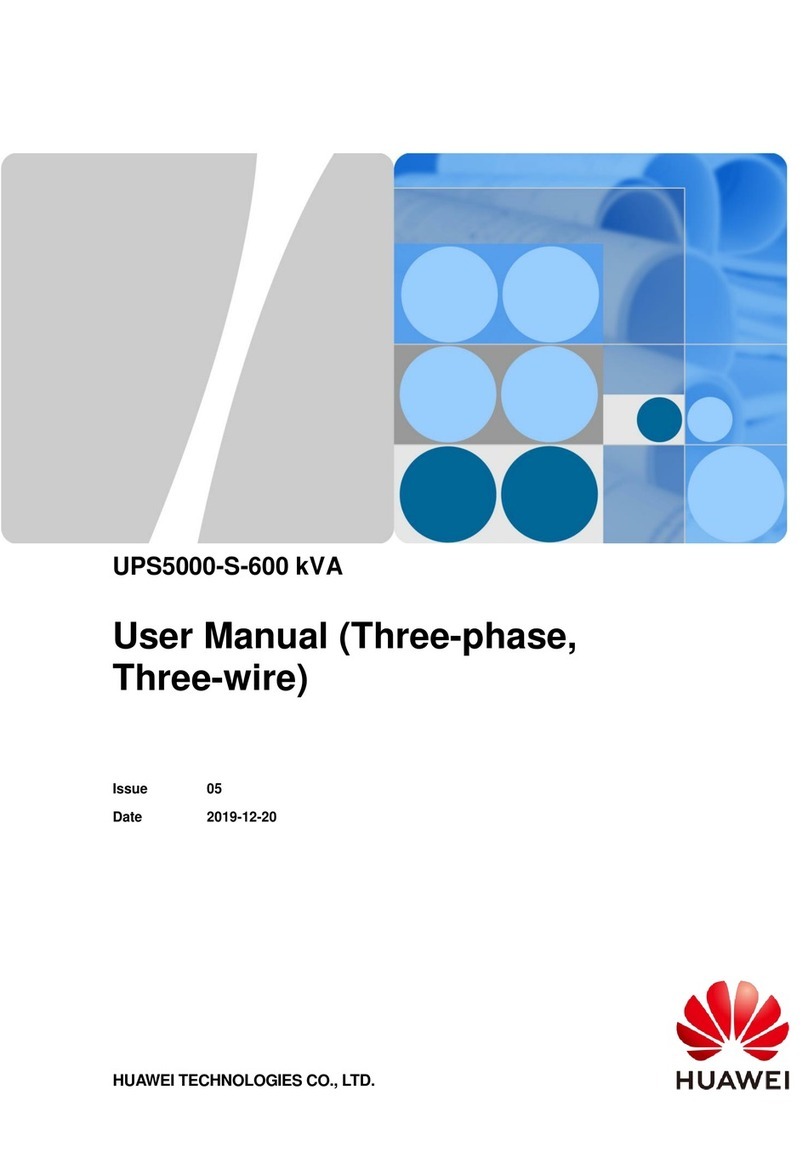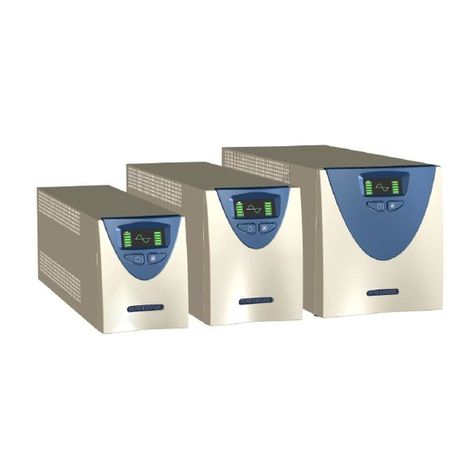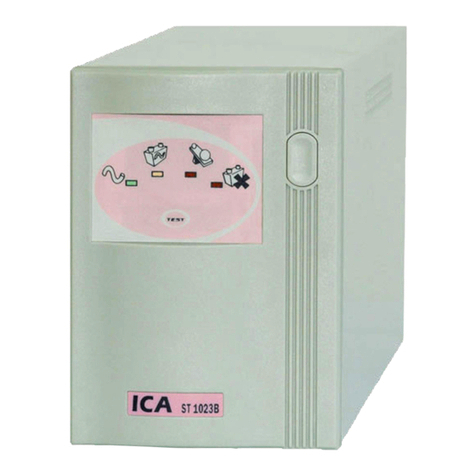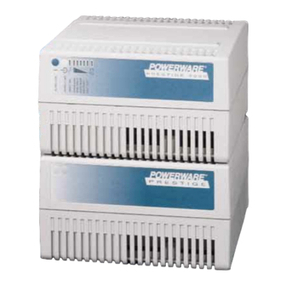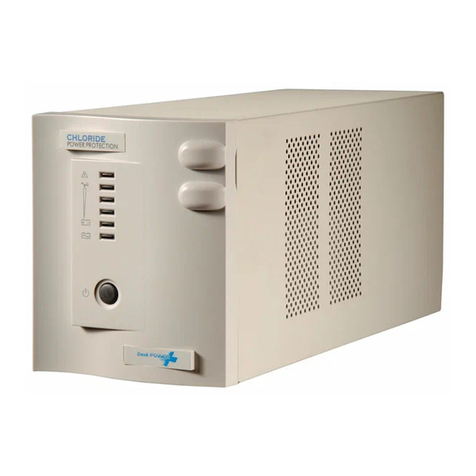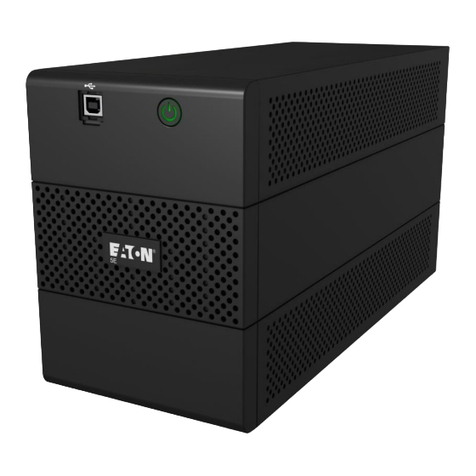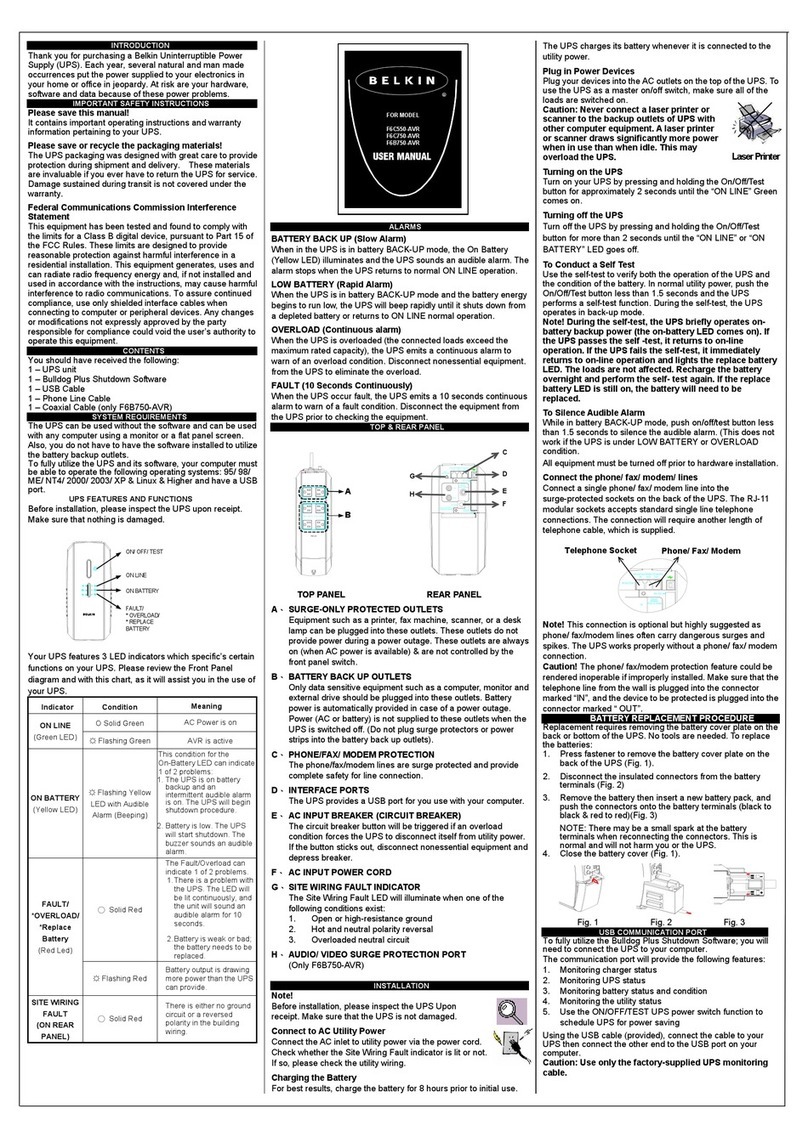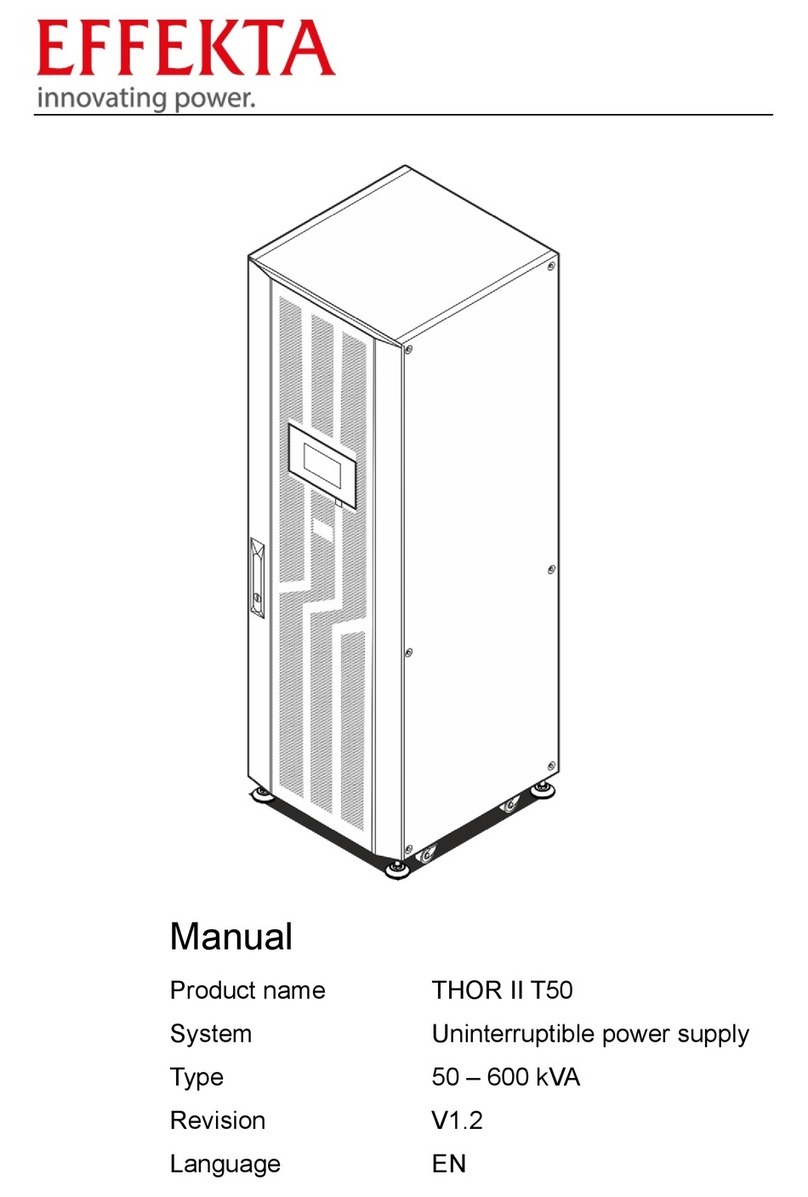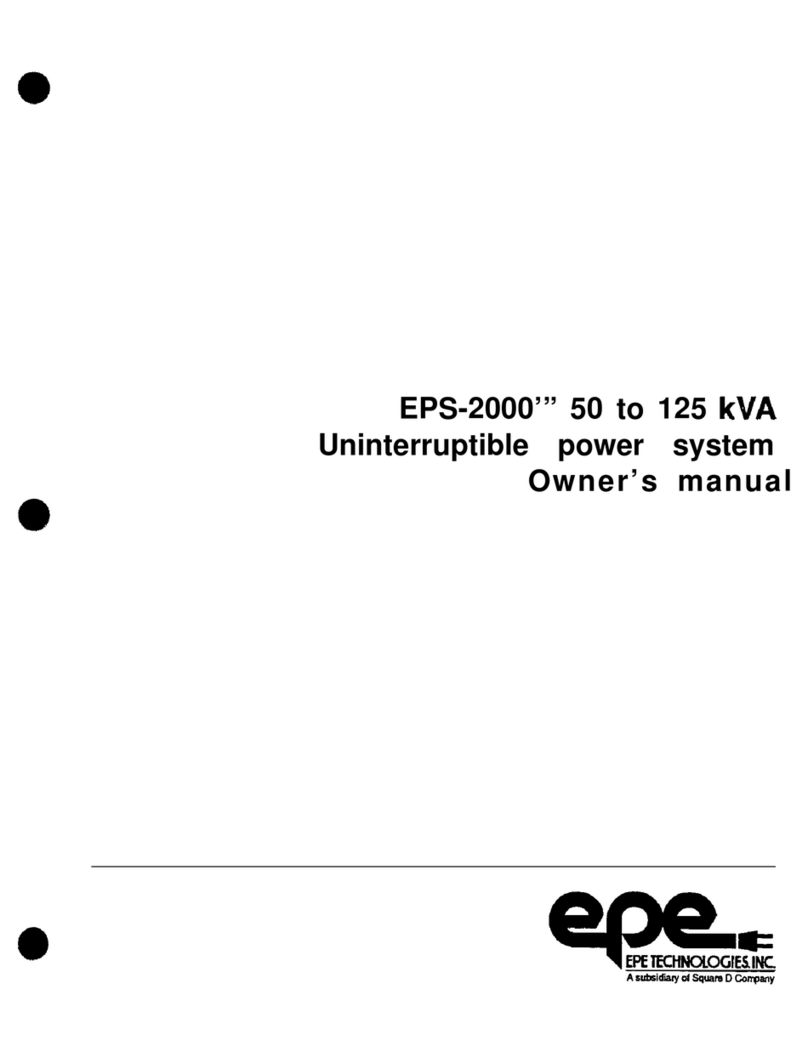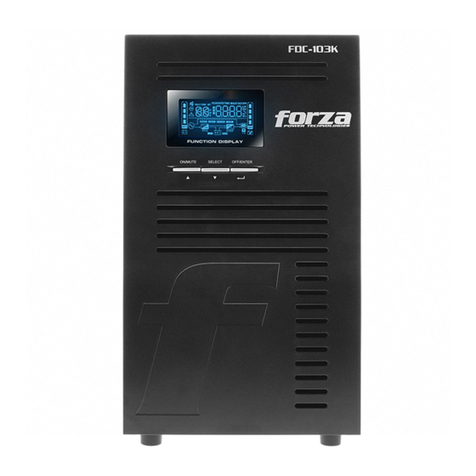El Ezza E1 Series User manual

E1 SERIES USER MANUAL
E1 Series 10-20kVA Rev 1.0.1 Page| 1
Table of Contents
1 Overview ............................................................................................................... 4
2 Safety .................................................................................................................... 5
2.1 Warnings (Please Read!) ................................................................................... 5
2.2 Explanation of Symbols ..................................................................................... 7
3 Installation ............................................................................................................ 8
3.1 Transportation ................................................................................................... 8
3.2 Unpacking ......................................................................................................... 8
3.3 Choosing the right location ................................................................................ 9
3.4 Electrical Connections ..................................................................................... 10
3.4.1 Input Feedback Protection ....................................................................... 10
3.4.2 Requirement Cross-Sections of Cable...................................................... 10
3.4.3 Cable Connections .................................................................................. 11
3.4.4 Cable Connections of External Battery Cabinet ........................................ 12
4 Operation Modes ................................................................................................ 14
4.1 Online Operation Modes .................................................................................. 14
4.1.1 Normal Mode .......................................................................................... 14
4.1.2 Battery Mode .......................................................................................... 14
4.1.3 Bypass Mode .......................................................................................... 15
4.2 Economic Operation Mode (ECO-MOD) ........................................................... 15
4.3 System Off Mode ............................................................................................ 15
4.4 Manual Bypass Mode ...................................................................................... 16
5 User Control and Communication Interfaces ..................................................... 17
5.1 Rear Panel ...................................................................................................... 17
6 Front Panel and Menu Structure ........................................................................ 18
6.1 Front Panel ..................................................................................................... 18
6.1.1 Data Monitoring Window .......................................................................... 20
6.2 Menu Structure................................................................................................ 21
6.2.1 Main Menus ............................................................................................ 22
7 Operating Procedures ........................................................................................ 31
7.1 Switching the UPS on ...................................................................................... 31
7.2 Starting the UPS ............................................................................................. 31
7.2.1 Starting the UPS from Mains.................................................................... 31
7.2.2 Starting the UPS from Battery(Optional) ................................................... 32
7.3 Stopping the UPS ............................................................................................ 33
7.4 Switching the UPS off ...................................................................................... 33
7.5 Manual Bypass Operation ................................................................................ 33
7.5.1 Switching the UPS Manual Bypass .......................................................... 34
7.5.2 Switching the UPS Back from Manual Bypass Mode ................................ 34
7.6 Economic Operation Mode (ECO-MOD) ........................................................... 35
7.6.1 Activating Economic Operation Mode ....................................................... 35
7.6.2 Deactivating Economic Operation Mode ................................................... 36
7.7 Emergency Stop Procedure ............................................................................. 36

E1 SERIES USER MANUAL
E1 Series 10-20kVA Rev 1.0.1 Page| 2
7.8 Operation During Mains Fail ............................................................................ 37
7.9 Remote start and stop of the UPS.................................................................... 38
7.10 Testing Batteries ....................................................................................... 39
7.10.1 Manual Test ............................................................................................ 39
7.10.2 Periodical Test ........................................................................................ 40
7.11 Operation on Generator ............................................................................. 40
7.12 Operation During an Overload ................................................................... 41
8 Parallel Operation ............................................................................................... 43
8.1 Installation ...................................................................................................... 43
8.2 Settings .......................................................................................................... 46
8.3 Starting parallel system ................................................................................... 48
8.4 Stopping parallel system ................................................................................. 49
8.4.1 Stopping any UPS in the system.............................................................. 49
8.4.2 Stopping all the UPSs in the system ........................................................ 50
9 Communication .................................................................................................. 51
9.1 RS–232 and RS–485 communication .............................................................. 51
9.2 Mod-bus communication option ....................................................................... 52
9.3 SNMP communication (Optionel) ..................................................................... 52
9.4 Remote monitoring panel (Optionel)................................................................. 53
9.5 Programmable relay unit ................................................................................. 54
9.6 Custom contacts ............................................................................................. 55
10 Battery Placement and Connection ................................................................... 57
10.1 UPS Cabinet ............................................................................................. 57
10.2 External Battery Cabinet ............................................................................ 58
11 Troubleshooting ................................................................................................. 60
12 Maintenance ....................................................................................................... 61
13 Technical Specification ...................................................................................... 62

E1 SERIES USER MANUAL
E1 Series 10-20kVA Rev 1.0.1 Page| 3
Introduction
Thank you for choosing our high technology E1 series uninterruptible power supply.
Product you purchased was manufactured as per ISO9001 quality assurance system
using most advanced technology.
In order to get highest efficiency from your product and to ensure a safe use, we
recommend that you strictly read and retain this user’s manual for later reference. In
addition, do not hesitate to contact your nearest authorized vendor or technical support
center for more detailed information and/or assistance.

E1 SERIES USER MANUAL
E1 Series 10-20kVA Rev 1.0.1 Page| 4
1 Overview
E1 Series Uninterruptible Power Supply (UPS) is a high technology product that
was manufactured to provide uninterruptible energy to fields including but not limited to
industrial facilities, hospital, schools, banks, business centers, and computer and
communication systems. You can use your device, which is equipped with static bypass
system, all necessary protection systems and an online structure with all loads safely.
Because this device was designed double conversion online system basis, it
supplies all connected loads with continuous voltage with stable frequency and stable
amplitude. Therefore, no transition period is necessary when electric power is
interrupted or recovered.
With deployment of a DSP (Digital Signal Processor) based microprocessor in
its design, UPS output voltage is accurately controlled, thereby ensuring stable
operation of devices that are sensitive to voltage fluctuations.
Static bypass unit of the system ensures that the mains voltage is constantly
kept at backup. In case of an overload, this system takes over the load uninterruptedly.
Once overload is recovered, load is transferred back to inverter. In addition, static
bypass unit acts in similar way in cases of UPS failure and prevents power shortage at
the system.
UPS will supply loads from the battery in cases of mains voltage outage. Loads
are supplied from the battery for a backup time that varies depending on the capacity of
batteries used. If mains voltage is recovered during the backup time, UPS will return to
online mode automatically and continue supplying power to loads. Meanwhile, batteries
are charged as well.
When UPS is connected to a computer system using any of a several
communication options, all functions of the device can be monitored by means of
designated software. Connecting to a remote device via modern is possible to transfer
information on device related functions and problems.
System used in E1 series uninterruptible power supply is shown in the following
simple block diagram.
Figure–1 UPS block structure

E1 SERIES USER MANUAL
E1 Series 10-20kVA Rev 1.0.1 Page| 5
2 Safety
This user manual contains all information pertaining to transportation,
installation and operation of E1 Series uninterruptible power supplies of 10-20 KVA
power range.
Be sure to read this user manual thoroughly before operating you UPS system.
Heed all warnings given in this user manual.
Please apply all instructions in respective order.
Please keep user manual thinking that you need it in future.
2.1 Warnings (Please Read!)
Life Safety
Use the UPS in room with restricted Access. (TS EN 62040-1-2).
The UPS has its own energy source. So, even all the switches are
thrown off, there will be energy at the output.
There is high voltage inside of the UPS. So, the UPS must be open
only by qualified service personnel.
The UPS must be grounded accordance with the rules.
Explosion Hazard: Do not litter batteries in fire.
Do not open the plastic cover of the batteries. Electrolyte liquid inside
batteries is highly hazardous to skin and eyes.
Comply with all applicable regulations for disposal of waste batteries.
Safe Transport
Be careful when moving the load. Do not carry heavy loads without
assistance.
Wheeled UPS must be move unhindered and smooth surfaces.
Do not use a ramp inclined more than 10° angle.
Follow the following recommendations for load weights.
An adult human can carry loads up to 18 kg.
Two adult human can carry loads up to 32 kg.
Three adult human can carry loads up to 55 kg.
Use pallet truck and forklift to move loads are heavy than 55 kg.

E1 SERIES USER MANUAL
E1 Series 10-20kVA Rev 1.0.1 Page| 6
UPS Safety
Strictly, do not carry the UPS in horizontal position. UPS must be
carried in upright (vertical) position only.
The UPS must be protected by a circuit breaker easily accessible in
short circuit and overload case.
If the environment temperature and relative humidity are out of value
specified in the manual, do not operate the UPS.
Do not operate the UPS with liquids or excessive moisture
environment.
Do not allow a liquid or a foreign object to enter into the UPS.
Do not block the ventilation grids located on the UPS.
Do not leave the UPS exposed to direct sunlight or heat source.
If connections of external batteries necessary, make sure only the
batteries that are compatible with device are connected and that
connection is made by authorized personnel only.
Lifetime of the UPS is 10 years.
Private Safety Information
Electrical connection of the UPS must be made as stated in manual.
Check the conformity of the total load and mains with the UPS.
The UPS must be stored in place is terms of moisture dry conditions
between -10°C and 45°C before installation.
The UPS must be operated at least once a month to charge batteries
during 24 hours.
Storage time is limited due to battery life starts in production date.
The UPS is design to run in altitude, operation environment
temperature, relative humidity ratio, transport and storage conditions
are stated in manual.
Special design and protection measures are necessary for abnormal
operating conditions. These conditions:
- Harmful fumes, abrasive dust
- Humidity, vapor, bad air, raw,
- Explosive dust and gas mixture,
- Over temperature variation,
- Bad ventilation,
- Be exposure to heat in direct or with radiation from other sources,
- Intense electromagnetic field,
- Harmful level of radioactive,
- Insect, rabble, fungus, etc.

E1 SERIES USER MANUAL
E1 Series 10-20kVA Rev 1.0.1 Page| 7
Replacing the Batteries and Recycling
Replacing the batteries must be done by authorized service staff.
Metal accessory as watch, ring are must be taken to prevent personal
accidents. Gumshoe and glove must be used.
Tools with dielectric handle must be used.
Be sure that battery connections did not grounded by mistake.
Do not put tool or metal accessory to above batteries.
Battery has an electric shock and short circuit shock.
Batteries must be replaced with batteries are same capacity and same
type, same quantity and same sizes.
Do not throw batteries in a fire, there is risk of explosion.
Recycle of batteries must be provided. Deliver batteries to any
recycling plant with packaging material of batteries.
If you face a problem when you perform directions in the manual, contact
with call center by using phone number and e-mail address on the rear
cover of the manual.
2.2 Explanation of Symbols
DANGER! HIGH VOLTAGE
CAUTION
HEAVY GOODS
SAFETY
RECYCLING
EARTH

E1 SERIES USER MANUAL
E1 Series 10-20kVA Rev 1.0.1 Page| 8
3 Installation
3.1 Transportation
Protection is provided against problems that can be compared when transport and
transfer period. So, the UPS must be carried by packed until the place which it will be
installed.
Make sure that the UPS is upright position when all transport and transfer
period.
The UPS must be carried by at least two people.
The UPS has wheels that are useable for short distance transport.
3.2 Unpacking
If UPS shall be kept at the depot for a prolonged period, do not remove
packaging until the installation.
Cut the black protection band shown in figure and remove the nylon protective
material inside the card box.
Remove nylon protective material.
Lift the carton upwards to remove.
Remove Styrofoam protective materials fit on upper corners of the UPS.
Place the UPS on the pallet carefully.
Figure–2 Unpacking
Once unpacked, examine the UPS carefully. UPS may have been
damaged during the transportation.
Check to ensure that all standard (user manual, communication cable, parallel cable
and warranty certificate) and optional products ordered were shipped with the
device without omissions.
Do not forget to throw packing material to the recycle bin.

E1 SERIES USER MANUAL
E1 Series 10-20kVA Rev 1.0.1 Page| 9
3.3 Choosing the right location
The UPS must be installed in restricted Access location. (Only authorized
personal).
Uninterruptible power supplies are devices that consist of highly delicate
circuits. Therefore, the environment to install and run UPS must be
carefully analyzed and chosen.
Platform that the UPS is placed must carry the entire weight of the UPS, it
must be straight and if it is possible, platform must be covered with
plastic.
Proposed temperature, humidity and altitude for the UPS are indicated in
technical specification (see chapter-14) chapter. The cooling devices provide
adequate ventilation must be located to keep installation environment within
values indicated.
Do not install the UPS on uneven ground or open area.
Be sure that ventilation hole on the side covers is not off.
Do not install the UPS in the places has a liquid system and fire risk.
Do not install the UPS in places that is exposed to sunlight or be affected from
heat sources.
Keep distances which are required between the UPS and wall and between
units (see Figure-3).
Do not install the UPS in places that the UPS is exposed to vibration and
impacts.
Do not install the UPS in the too high humidity places or too low humidity
places.
Do not run the UPS in dusty and dirty environments.
There must not be burning gas as hydrogen, sulphur, sulphuric acid, chloride,
ammonium, nitric acid, ozone, hydrochloric acid in operating environment.
Figure–3 UPS placement

E1 SERIES USER MANUAL
E1 Series 10-20kVA Rev 1.0.1 Page| 10
The UPS must be installed according to standards below:
TS HD 384.4.42 S1: Electric Wiring in Buildings chapter 4: Protection for S
group 42: Protection against Thermal Effect.
TS HD 384.4.482.S1: Electric Wiring in Buildings chapter 4: Safety Protection-
Group 48: Choosing of Protective Measures Which is Depend on External
Effects-Section 482: Protection against Fire at the Places Where There Are
Special Risk or Danger.
3.4 Electrical Connections
Three phases and neutral (3P+N) must be connected to input of the UPS to run
the UPS.
3.4.1 Input Feedback Protection
This UPS includes no internal circuit for protection against feedback currents.
Therefore, it is essential that users or those who installed the UPS put warning labels on
all circuit interrupt switches deployed on the line where uninterruptible power supply is
used. Warning labels should remind that a UPS device is operating on this line to
technical personnel to service these circuits. Warning labels should be as follows.
BE SURE TO ISOLATE THE UPS
PRIOR TO SERVICING THIS CIRCUIT
3.4.2 Requirement Cross-Sections of Cable
Requirement cross-sections of cables to be used are given in the
following table. Be sure to adhere to following cable cross-section
specifications for a safe operation.
Cable Cross
-
Section
(mm²)
Circuit Breaker (A)
10KVA
15KVA
20KVA
10KVA
15KVA
20KVA
Input
4x4 4x4 4x6 C 3x25 C 3x40 C 3x50
Output
4x4 4x4 4x6 C 3x25 C 3x40 C 3x50
Internal Battery
3x6 3x6 3x6 C 3x32 C 3x50 C 3x63
External Battery
3x6 3x6 3x6 C 3x32 C 3x50 C 3x63
Manua
l Bypass
4x4 4x4 4x6 C 4x25 C 4x32 C 4x50
Earth
1x4 1x4 1x6
Figure–1 Cable cross-section

E1 SERIES USER MANUAL
E1 Series 10-20kVA Rev 1.0.1 Page| 11
3.4.3 Cable Connections
Rear view and connection terminals are shown in figure below. Explanation of
connection terminals are given in table-2.
Figure–4 Rear view and connection terminals of the UPS
Be sure that all circuit breakers at the power circuit breaker unit are off.
No. Connection Terminals
1 Battery (External
Battery Cabinet)
+ N -
(+) pole Midpoint
(-) pole
2 INPUT
R S T N1 E1
R phase S phase T phase Neutral Earth
3 OUTPUT
U V W N2 E2
U phase V phase W phase Neutral Earth
Figure-2 Connection terminals of the UPS
Firstly, EARTH (E1 and E2) must be connected to connection
terminal of the UPS.

E1 SERIES USER MANUAL
E1 Series 10-20kVA Rev 1.0.1 Page| 12
Connect earth cable to terminal is named ‘EARTH’ (E1 and E2).
Make sure that phase sequence when connect input cables. If phase
sequence is failure, the UPS will not run.
Connect input cables to input terminals (R), (S), (T).
Connect output cables to output terminals (U), (V), (W) and (N2) in sequence.
If external battery cabinet is not used, do not make any connection to
battery terminals.
3.4.4 Cable Connections of External Battery Cabinet
When a backup time that is longer than backup time normally provided by the
internal battery group is necessary, batteries designated by the manufacturer may be
connected externally. In that case, follow the steps below to connect batteries located
inside external tray(s) to device.
The information is given about external battery cabinets of 7Ah, 9Ah, 12Ah
batteries in this chapter. Please, contact with producing company to use high
capacity battery.
Capacity of external batteries must be same with capacity of internal batteries.
Be sure that power circuit breaker of the external battery cabinet is off and
there is not energy at the connection terminals.
Be sure that power circuit breaker of the UPS is off and there is not energy at
the connection terminals.
Connect earth cable before all connections.

E1 SERIES USER MANUAL
E1 Series 10-20kVA Rev 1.0.1 Page| 13
Figure-5 External battery cabinet and the UPS connections.
Make a connection from ‘+’ terminal of external battery cabinet to ‘+’ terminal of
the UPS and from ‘N’ terminal of external battery cabinet to ‘N’ terminal of the
UPS and from ‘-’ terminal of external battery cabinet to ‘-’ terminal of the UPS
(see figure-5).
Be sure that polarity of battery cables when connect battery cables.
If there is polarity failure, the UPS will be damaged.
1. If a distance between the UPS and external battery cabinet is over one meter,
span battery cables in wrapped around each other.
2. A distance between the UPS and external battery cabinet must not be more
than 3 meter. Contact with producing company for long distance.
3. Placement and connections for external and internal batteries is given in
chapter-11. Please read related chapter before place batteries.

E1 SERIES USER MANUAL
E1 Series 10-20kVA Rev 1.0.1 Page| 14
4 Operation Modes
4.1 Online Operation Modes
4.1.1 Normal Mode
E1 Series UPS devices supply all connected loads with continuous voltage with
stable frequency and stable amplitude during online operation. Rectifier and inverter
units run continuously. Load is supplied with a stable sinusoidal voltage generated by
the inverter. Inverter and bypass voltages are synchronized. So, uninterruptable load
transfer can be done in the UPS. Batteries are constantly kept at a buffer charge
voltage. Mimic diagram displayed on the LCD screen is as shown in figure-6 below.
During this operation mode, LED bar is constantly lit in green.
Figure–6 Normal mode
UPS will switch back from this operation mode when any of the following occurs:
Mains voltage or mains frequency is out of limits
Overheat or overload
Battery test procedure
A failure
4.1.2 Battery Mode
Rectifier unit does not run, inverter unit runs. Inverter unit is supplied from the
battery. Load is supplied a stable sinusoidal voltage generated by the inverter. Batteries
are in discharge position. Mimic diagram is as shown in the figure7. In this operation
mode, LED bar flashes green.
Figure–7 Battery Mode
When any of the following occurs, UPS will switch to this operation mode.
Mains voltage or mains frequency is out of limits
Mains phase sequence fault
Battery test procedure

E1 SERIES USER MANUAL
E1 Series 10-20kVA Rev 1.0.1 Page| 15
4.1.3 Bypass Mode
Inverter and rectifier units do not run. Load is supplied by bypass source over
static bypass unit. Mimic diagram is as shown in the figure-8. In this operation mode,
LED bar is constantly lit in red.
Figure–8 Bypass mode
When any of the following occurs, UPS will switch to this operation mode.
As soon as UPS is turned on
Cases of overheat shutdown, overload shutdown or over current inverter
Stopping the UPS by remote bypass switch
Any failures in rectifier or inverter stages
4.2 Economic Operation Mode (ECO-MOD)
Load is fed from bypass source instead of energy is produced by the UPS in
this mode. Rectifier and inverter units run in this mode. The Voltage, frequency and
waveform of bypass source are continuously monitored. Inverter voltage is kept ready as
synchronous with bypass source. Mimic diagram is as shown in the figure-9. In this
operation mode, LED bar is constantly lit in red.
Load is transferred to the inverter unit automatically when voltage or frequency
of bypass source is out of limit. Load is transferred to the bypass automatically when
voltage or frequency of bypass source returns to normal limits.
Figure- 9 Economic operation mode
Batteries are kept in charge in this mode. Rectifier unit is stopped, inverter unit
start to feed from batteries and batteries start to discharge when mains voltage is out of
limit. If mains voltages return to normal limits, rectifier will step in and batteries start to
charge.
4.3 System Off Mode
Rectifier, inverter and static bypass units do not run. In this operation mode, LED
bar will be fully off. Mimic diagram is as shown in the figure-10.

E1 SERIES USER MANUAL
E1 Series 10-20kVA Rev 1.0.1 Page| 16
Figure- 10 System off mode
UPS will switch to this operation mode if any of the following occurs.
Stopping the UPS by ‘EPO’ switch
Stopping the UPS through a computer (shutdown).
Bypass voltage and frequency is out of limits during bypass operation mode
Static bypass switch (SCR) malfunction during bypass operation mode
Shutdown due to overheat or overload during stop mode
4.4 Manual Bypass Mode
Load is fed from mains in this mode. Load will be transferred to mains without any
problem when steps in operating procedure are carried out. The UPS can be turned off
due to load feed from mains. This operation mode is used for maintenance.
Maintenance and repair of the UPS can be done by authorized personnel without cut the
power.

E1 SERIES USER MANUAL
E1 Series 10-20kVA Rev 1.0.1 Page| 17
5 User Control and Communication Interfaces
5.1 Rear Panel
Placement of control and communication interfaces at the rear panel is explained
in this chapter (see Figure-11 and Table-3).
No. Part
1 Dry Contacts Socket (see Chapter-10
Communication)
2 SNMP (see Chapter-10
Communication)
3 RS232 Socket (see chapter-10
Communication)
4 RS485 Socket (see Chapter-10
Communication)
5 Remote Monitoring Panel Socket (see
Chapter-10 Communication)
6 Custom Contacts Socket (see Chapter-
10 Communication)
7 External Heat Sensor Input
8 Parallel Operation Card Sockets
(Optional)
9 Fans
10 Manual Bypass Fuse Cover
11 Manual Bypass Fuse
12 Internal Battery Fuse
13 Input Fuse
14 Output Fuse
15 Connection Cover
Figure-11 Rear panel view
Table-3 Rear panel

E1 SERIES USER MANUAL
E1 Series 10-20kVA Rev 1.0.1 Page| 18
6 Front Panel and Menu Structure
6.1 Front Panel
Figure-12 Front panel
Keypad
Keypad is used to switch on or off the UPS, to browse through menu options, to
monitor UPS data and to change as necessary (see Figure-12 and Table4).
No. BUTTON
>3 sec.
(Press longer than 3
second)
<3 sec.
(Press less than 3 second)
1 ON/OFF Turn on
Turn off
In normal mode: cancel execution/task
In bypass mode: confirm execution/task
Turning on/off warning sound
Turning back mimic diagram
2 ESC -
Exit from selected parameter
Exit from sub-menu
Entry to main menu from intermediate
menu
3 ENTER -
Entry to intermediate menu from main
menu
Entry to sub-menu from intermediate menu
Item selection
Value saving
4 UP
ARROW -
Increase value
Move UP in sub menu
Move UP in intermediate menu
Move UP in main menu
5 DOWN
ARROW -
Decrease value
Move DOWN in sub menu
Move DOWN in intermediate menu
Move DOWN in main menu
Table-4 Front Panel Keypad

E1 SERIES USER MANUAL
E1 Series 10-20kVA Rev 1.0.1 Page| 19
6. LED Bar
LED Bar indicates the current operation mode of the UPS in different colors (see
Table-5)
Green Constantly Lit Normal operation mode
Flashing Battery operation mode
Red Constantly Lit Bypass operation mode
Flashing Economic operation mode (Eco-mod)
Off System off
Table-5 LED bar situations
7. LCD Screen
This screen is used for monitoring purposes (see Figure-13). LCD screen
displays input, output and battery data, UPS’s current operation mode, warning and
failure information, system date and time, and UPS’s internal temperature. There are
two windows in LCD screen. First window include mimic diagram and alarm information
section. Data and status information about the UPS is monitored and make changes to
parameters and settings in the second window.
Figure–13 Mimic diagram window
Mimic diagram
This is a graphical diagram. Diagram features symbols denoting input, output,
battery, rectifier and inverter units and paths that indicate the current operating mode of
the UPS. Moreover, there is a bar that indicates battery charge level in battery indicator
and another bar that indicates load percentage. This bar graph is filled or emptied
depending on battery and load percentages. This way, user will be able to tell the
current condition of the UPS at a glance.
Alarm information section
This is the lower portion of mimic diagram window and consists of two lines.
This section shows active alarm and failure information of the UPS. Alarm information is

E1 SERIES USER MANUAL
E1 Series 10-20kVA Rev 1.0.1 Page| 20
displayed in this section for as long as alarm condition continues. If there are multiple
alarms, these are displayed in this section alternately (see Figure-14).
Figure–14 Alarm information window (alarm status)
Whenever there is no alarm or failure, certain important information such as
system date and time, device internal temperature etc. is displayed in this section (see
Figure-15).
Figure–15 Alarm information window (without any alarm condition)
6.1.1 Data Monitoring Window
You can monitor data and status information about the UPS and make changes
to parameters and settings using this menu structure.
Figure–16 Data monitoring window
Table of contents
